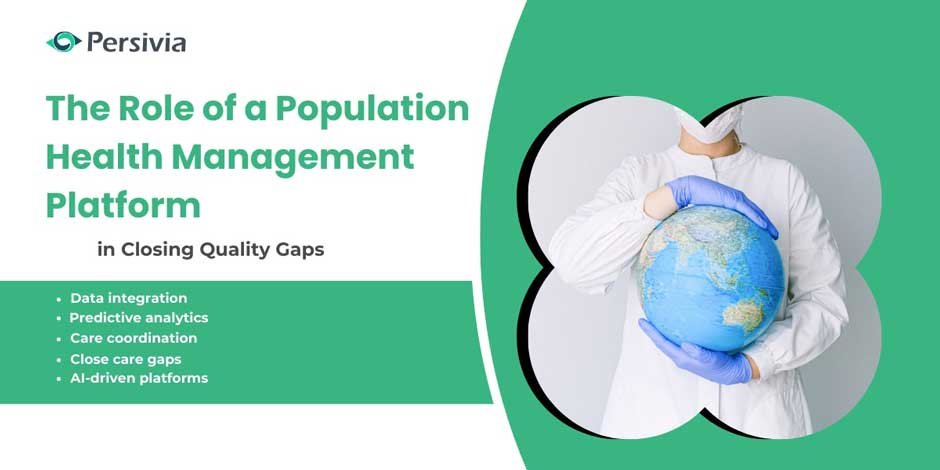A Population Health Management Platform identifies care gaps with AI-assisted analytics, links disparate data sources to provide full views of patients, and automates care coordination to enhance quality measures. These interfaces minimise the cost of manual labour and result in superior clinical performance by providing evidence-based clinical pathways and real-time knowledge.
There is ever-increasing pressure on healthcare organizations to meet high standards of care delivery and control costs. Quality gaps imply wasted opportunities in which patients fail to get the recommended care according to the clinical standards. The ultimate solution to filling these gaps is a Population Health Management Platform, which is used to develop systematic methods to address them. Artificial intelligence on modern platforms allows for processing enormous quantities of patient information, predicting risks, and integrating the delivery of care across the whole population.
What Are Quality Gaps in Healthcare?
Quality gaps appear when patients don’t get care aligned with clinical guidelines. These gaps appear as:
- Missed preventive screenings like mammograms or colonoscopies
- Delayed medication adjustments for chronic conditions
- Incomplete vaccinations or health assessments
- Lack of follow-up care after hospital discharge
- Inadequate monitoring of high-risk patients
Healthcare systems lose revenue and face penalties when quality gaps persist. More importantly, patients experience worse health outcomes and higher costs.
How Does a Population Health Management Platform Identify Quality Gaps?
Advanced analytics can be implemented on health management platforms to scan patient records and highlight the presence of gaps. The system allows the comparison of every patient care and quality measure against clinical guidance.
Key identification methods include:
- Risk stratification algorithms that categorize patients by health complexity
- Automated screening of electronic health records for care gaps
- Predictive modeling to identify patients likely to develop complications
- Real-time alerts for providers about overdue services
- Comparative analysis across patient populations to spot trends
Contemporary platforms do simultaneous data analytics across sources. To construct full patient profiles, they review laboratory results, medication lists, appointment histories, and insurance claims.
The Role of AI in Closing Quality Gaps
Artificial intelligence is changing the perspective of population health management in health care organizations. Such systems powered by AI can analyze massive amounts of data more quickly than manually executed reviewers and do it more accurately.
Population health management analytics powered by AI deliver several advantages:
- Automated eligibility determination for care programs based on clinical criteria
- Dynamic risk adjustment that updates as patient conditions change
- Intelligent care plan generation using evidence-based protocols
- Predictive insights about which patients need immediate attention
- Pattern recognition to identify systemic quality issues
AI eliminates the manual work of reviewing thousands of patient records. Instead, the system automatically identifies priority cases and suggests specific interventions.
Data Integration: Creating a Complete Patient View
The lack of coordinated information causes care gaps. A population management platform is a comprehensive data-centric platform that uses multiple data sources to build longitudinal records of patient data.
Essential data sources include:
- Electronic medical records (EMR) and practice management systems
- Health information exchanges (HIE) with clinical data
- Insurance claims containing service histories
- Laboratory systems with test results
- Pharmacy records showing medication adherence
- Hospital discharge summaries and care transitions
Population health management tools put this data into normalized forms. The platform will subsequently give a unified perspective of displaying the entire health journey of every patient across various providers and settings.
Organizations can benefit from integrating modern, user-friendly tools such as Canvas Medical EMRs for streamlined charting and documentation workflows. When paired with a robust population health management platform, these EMRs help to surface actionable insights and bridge existing quality gaps without creating workflow disruption.
Evidence-Based Care Pathways
Standardized care pathways help close gaps by guiding clinical decisions based on evidence. Modern platforms include them by default.
These pathways provide:
- Step-by-step protocols for managing specific conditions like diabetes or hypertension
- Automated reminders for routine screenings and preventive care
- Clinical decision support with real-time recommendations
- Outcome tracking to measure pathway effectiveness
- Customization options to match organizational preferences
Care pathways reduce variation in treatment approaches while ensuring patients receive appropriate care at the right intervals.
Automated Care Coordination
Manual care coordination is slow and error-prone. These platforms automate coordination to ensure timely and consistent care.
Automation features include:
- Workflow triggers that activate when care gaps are identified
- Task assignment to appropriate care team members
- Patient outreach through automated calls, texts, or emails
- Appointment scheduling integration with provider calendars
- Progress tracking with real-time status updates
This systematic approach prevents patients from falling through the cracks while reducing administrative burden on clinical staff.
Measuring Success: Quality Metrics and Outcomes
Population health management analytics monitors various quality measures to indicate the effectiveness of gap closure. Healthcare organisations measure both process outcomes and clinical outcomes.
| Metric Type | Examples | Target Goals |
| Process Measures | Screening rates, vaccination percentages | 90%+ completion |
| Clinical Outcomes | HbA1c control, blood pressure management | Evidence-based targets |
| Patient Experience | Access to care, communication scores | Top quartile performance |
| Cost Efficiency | Per-member costs, hospital readmissions | Year-over-year reduction |
Note: Regular measurement helps organizations identify successful strategies and areas needing improvement.
Patient Engagement in Quality Gap Closure
Patients play a key role in closing gaps. Engagement tools in modern platforms help keep them involved and proactive.
Engagement strategies include:
- Personalized health reminders sent via preferred communication channels
- Educational materials tailored to individual health conditions
- Self-service portals for scheduling appointments and viewing results
- Mobile apps with health tracking and medication reminders
- Care team messaging for questions and support
When patients understand their care needs and have convenient access to services, quality gaps close more rapidly.
Overcoming Implementation Challenges
Healthcare organizations face several challenges when implementing population health management solutions. Success requires addressing technical, clinical, and cultural barriers.
Common implementation challenges:
- Data quality issues with incomplete or inaccurate patient information
- Workflow disruption during system integration and staff training
- Provider resistance to new processes and technology adoption
- Resource constraints, including staffing and budget limitations
- Interoperability problems between different healthcare systems
Organizations succeed by starting with pilot programs, providing comprehensive training, and demonstrating early wins to build momentum.
Bottom Line
Population Health Platforms give healthcare organizations the clarity, structure, and tools to close care gaps at scale. With AI, data integration, and care automation, your team can focus on what matters, i.e., delivering timely, consistent care that improves outcomes and reduces waste.
Ready to transform your Population Health Management protocol?
Persivia CareSpace® features the gold standard of AI-enabled population health management. We have 70+ EMR system-integrating capabilities and more than one hundred million patient record management responsibilities to provide the clinical insights your organization requires to seal the quality gap and act on patient outcomes.
Persivia is a 360° solution of advanced analytics and proven clinical experience that assists healthcare organizations in meeting quality, cost, and experience objectives. Our AI-powered tools do all that and automatically determine potentially at-risk populations, develop evidence-based care plans, and coordinate interventions with your whole patient population.
Contact Our Experts Now.













